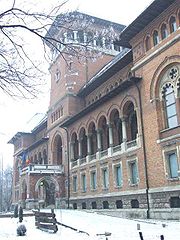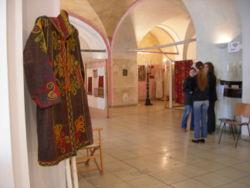
Museum of the Romanian Peasant
Encyclopedia

Museum
A museum is an institution that cares for a collection of artifacts and other objects of scientific, artistic, cultural, or historical importance and makes them available for public viewing through exhibits that may be permanent or temporary. Most large museums are located in major cities...
in Bucharest
Bucharest
Bucharest is the capital municipality, cultural, industrial, and financial centre of Romania. It is the largest city in Romania, located in the southeast of the country, at , and lies on the banks of the Dâmbovița River....
, Romania
Romania
Romania is a country located at the crossroads of Central and Southeastern Europe, on the Lower Danube, within and outside the Carpathian arch, bordering on the Black Sea...
, with a collection of textile
Textile
A textile or cloth is a flexible woven material consisting of a network of natural or artificial fibres often referred to as thread or yarn. Yarn is produced by spinning raw fibres of wool, flax, cotton, or other material to produce long strands...
s (especially costume
Costume
The term costume can refer to wardrobe and dress in general, or to the distinctive style of dress of a particular people, class, or period. Costume may also refer to the artistic arrangement of accessories in a picture, statue, poem, or play, appropriate to the time, place, or other circumstances...
s), icon
Icon
An icon is a religious work of art, most commonly a painting, from Eastern Christianity and in certain Eastern Catholic churches...
s, ceramics
Ceramics (art)
In art history, ceramics and ceramic art mean art objects such as figures, tiles, and tableware made from clay and other raw materials by the process of pottery. Some ceramic products are regarded as fine art, while others are regarded as decorative, industrial or applied art objects, or as...
, and other artifacts of Romanian peasant
Peasant
A peasant is an agricultural worker who generally tend to be poor and homeless-Etymology:The word is derived from 15th century French païsant meaning one from the pays, or countryside, ultimately from the Latin pagus, or outlying administrative district.- Position in society :Peasants typically...
life. One of Europe
Europe
Europe is, by convention, one of the world's seven continents. Comprising the westernmost peninsula of Eurasia, Europe is generally 'divided' from Asia to its east by the watershed divides of the Ural and Caucasus Mountains, the Ural River, the Caspian and Black Seas, and the waterways connecting...
's leading museums of popular arts and traditions, it was designated "European Museum of the Year
European Museum of the Year Award
The European Museum of the Year Award , established in 1977, is presented each year by the European Museum Forum , under the Council of Europe...
" for 1996.
Located on Şoseaua Kiseleff
Soseaua Kiseleff
Şoseaua Kiseleff is a major road in Bucharest that runs as a northward continuation of Calea Victoriei. The road was created in 1832 by Pavel Kiselyov, the commander of the Russian occupation troops in Wallachia and Moldavia...
, near Piaţa Victoriei, the museum falls under the patronage of the Romanian Ministry of Culture. Its collection includes over 100,000 objects.

Alexandru Tzigara-Samurcaş
Alexandru Tzigara-Samurcaş was a Romanian art historian, ethnographer, museologist and cultural journalist, also known as local champion of art conservation, Romanian Police leader and pioneer radio broadcaster...
, the museum was reopened February 5, 1990, a mere six weeks after the downfall and execution of Nicolae Ceauşescu
Nicolae Ceausescu
Nicolae Ceaușescu was a Romanian Communist politician. He was General Secretary of the Romanian Communist Party from 1965 to 1989, and as such was the country's second and last Communist leader...
. During the Communist era
Communist Romania
Communist Romania was the period in Romanian history when that country was a Soviet-aligned communist state in the Eastern Bloc, with the dominant role of Romanian Communist Party enshrined in its successive constitutions...
, the building housed a museum representing the country's Communist party; the museum's basement still contains a room devoted to an ironic
Irony
Irony is a rhetorical device, literary technique, or situation in which there is a sharp incongruity or discordance that goes beyond the simple and evident intention of words or actions...
display of some artifacts from that earlier museum. The building, which uses traditional Romanian architectural features, was built on the former site of the State Mint
Mint (coin)
A mint is an industrial facility which manufactures coins for currency.The history of mints correlates closely with the history of coins. One difference is that the history of the mint is usually closely tied to the political situation of an era...
(Monetăria Statului).
The museum was devastated during the June 1990 Mineriad
Mineriad
See also The 1990s: the rise and decline of miners' unionsA Mineriad is the term used to name any of the successive violent interventions of miners in Bucharest. These interventions were generally seen as aimed at wrestling policy changes or simply material advantages from the current political...
, due to being confused with the headquarters of the National Peasants' Party
National Peasants' Party
The National Peasants' Party was a Romanian political party, formed in 1926 through the fusion of the Romanian National Party from Transylvania and the Peasants' Party . It was in power between 1928 and 1933, with brief interruptions...
.

Gorj County
Gorj is a county of Romania, in Oltenia, with its capital city at Târgu Jiu.- Demographics :In 2002, it had a population of 387,308 and its population density was 69/km².* Romanians – over 98%* Rromas, others.- Geography :...
. From the first, the house was displayed in a non-naturalistic way: objects that would normally be in the interior were displayed in various manners outside; outbuildings were suggested by fragments. The Communist regime
Communist Romania
Communist Romania was the period in Romanian history when that country was a Soviet-aligned communist state in the Eastern Bloc, with the dominant role of Romanian Communist Party enshrined in its successive constitutions...
displayed the house much more conventionally, outdoors at the Village Museum
Village Museum
The Village Museum is an open-air ethnographic museum located in the Herăstrău Park , showcasing traditional Romanian village life. The museum extends to over 100,000 m2, and contains 272 authentic peasant farms and houses from all over Romania.It was created in 1936 by Dimitrie Gusti, Victor Ion...
; it returned to the Peasant Museum in 2002. The current display at the Peasant Museum revives the original non-naturalistic approach. For example, from a platform, museum visitors may peer into the attic, part of whose wall is stripped away; various objects are arranged inside.
In 2002, the museum's exhibit space was greatly expanded as the museum store and offices moved into a new building behind the old one, freeing up a considerable amount of floor space in the museum proper.

